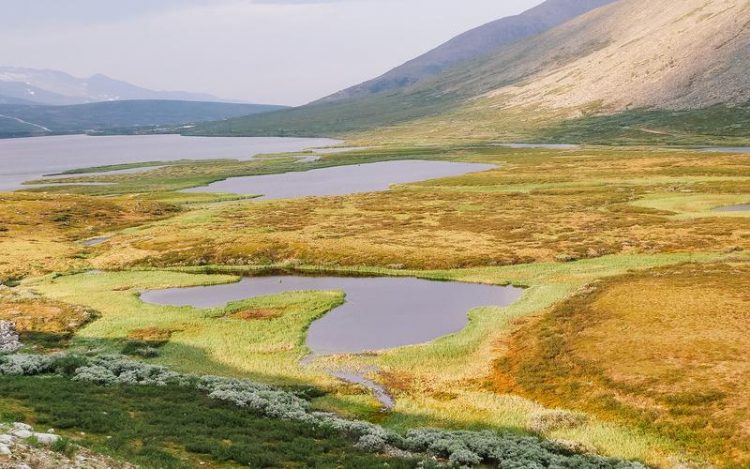Thawing Arctic Permafrost: One of the Five Largest Threats to the Environment

Permafrost peatlands in the Republic of Komi Hans Joosten
Approximately 23 million square kilometres of the world’s northern regions are subject to permafrost – ground that remains at sub-zero temperatures all year round. These are mainly peat soils, which – if frozen – store about half of the carbon that is locked in soils worldwide.
When they thaw due to the warming climate, the carbon is released into the atmosphere as greenhouse gases (carbon dioxide and methane). In recent decades, the southern boundaries of the permafrost regions have receded northwards by 30 to 80 km – a significant loss in coverage.
Thawing and dry (often drained) peatlands hold additional dangers: Peat fires, which can burn underground for months and are hard to extinguish, cause further emissions and pose a health risk to people living in large-scale regions. Mining, agriculture and growing infrastructure projects are another menace to permafrost, which also serves as living space for indigenous people.
Thawing permafrost is considered one of the tipping points in global warming. The report sees the Arctic permafrost and its peatlands already subject to rapid changes and calls for urgent protection, conservation and prudent management of permafrost peatlands.
Aside from detailed background information, the report offers a new circumpolar map on the distribution of permafrost and Arctic peatlands based on the Global Peatland Database of the Greifswald Mire Centre.
The Greifswald Mire Centre is a partnership between the University of Greifswald, the Michael Succow Foundation and the Institute of Sustainable Development of Landscapes of the Earth (German: Institut für Dauerhaft Umweltgerechte Entwicklung von Naturräumen der Erde, DUENE e.V.).
About the author
Prof. Dr. Dr. h.c. Hans Joosten is peatland scientist and paleoecologist at the University of Greifswald’s Institute of Botany and Landscape Ecology . He also is General Secretary of the International Mire Conservation Group (IMCG), the worldwide organisation of peatland conservationists, and co-founder of the Greifswald Mire Centre.
Prof. Dr. Dr. h.c. Hans Joosten
Institute of Botany and Landscape Ecology.
Soldmannstraße 15, 17489 Greifswald
Tel.: +49 3834 420 4177
joosten@uni-greifswald.de
Dr. Franziska Tanneberger
Tel.: +49 3834 420 4137
tanne@uni-greifswald.de
https://wedocs.unep.org/bitstream/handle/20.500.11822/27542/Frontiers1819_ch3.pd….
https://www.unenvironment.org/resources/frontiers-201819-emerging-issues-environ…
Media Contact
More Information:
https://www.uni-greifswald.deAll latest news from the category: Earth Sciences
Earth Sciences (also referred to as Geosciences), which deals with basic issues surrounding our planet, plays a vital role in the area of energy and raw materials supply.
Earth Sciences comprises subjects such as geology, geography, geological informatics, paleontology, mineralogy, petrography, crystallography, geophysics, geodesy, glaciology, cartography, photogrammetry, meteorology and seismology, early-warning systems, earthquake research and polar research.
Newest articles

First-of-its-kind study uses remote sensing to monitor plastic debris in rivers and lakes
Remote sensing creates a cost-effective solution to monitoring plastic pollution. A first-of-its-kind study from researchers at the University of Minnesota Twin Cities shows how remote sensing can help monitor and…

Laser-based artificial neuron mimics nerve cell functions at lightning speed
With a processing speed a billion times faster than nature, chip-based laser neuron could help advance AI tasks such as pattern recognition and sequence prediction. Researchers have developed a laser-based…

Optimising the processing of plastic waste
Just one look in the yellow bin reveals a colourful jumble of different types of plastic. However, the purer and more uniform plastic waste is, the easier it is to…



